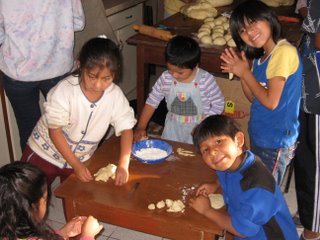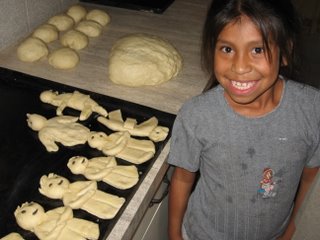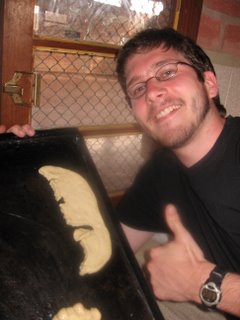This week marked the celebration a centuries-old tradition in Bolivia, and many other parts of Latin America, known as La Fiesta de Todos Santos. Beginning at noon on November 1st and lasting until noon on November 2nd, this celebration is dedicated to the souls of the recently departed. La Fiesta de Todos Santos originated during the time of the Spanish conquest of Latin America and was used by the indigenous inhabitants as a way to combat the imposition of Spanish religion upon traditional practices. In order to honor and welcome the spirits of friends during these sacred days, family members, and other loved ones, Bolivians prepare tables of various offerings. Each offering holds a specific significance for the soul to be welcomed and usually reflects something that the departed enjoyed in life. Pictures, cigars, fruits, sweets, chicas (typical Andean beverage that may or may not contain alcohol), and plates of food are common offerings. However, no table is complete without the requisite ´´masas de pan.´´ These creations of bread from large masses of dough take many forms. The most popular is the T´antawawa, a Quechua word for bread baby. These babies represent the figure of a departed loved one and are often adorned with colorful faces. Another typical form is the ladder, which is often placed in the rear of the table and serves as a way for the soul to descend from the heavens and return upon the completion of the celebration.
In the Villa, we prepared for Todos Santos by making hundreds of T´antawawas, ladders, crosses, horses, llamas, stars, suns, etc. in our very own ´´panadería.´´
 Children and mamás from all seven houses spent Tuesday afternoon molding the enormous quantity of dough into all kinds of creative forms. I tried my hand at this surprisingly difficult task (six-year-old children were putting my moldings to shame, compare our work in the photos)
Children and mamás from all seven houses spent Tuesday afternoon molding the enormous quantity of dough into all kinds of creative forms. I tried my hand at this surprisingly difficult task (six-year-old children were putting my moldings to shame, compare our work in the photos)
 and managed to form several resemblences of stars, suns, moons, and hearts. All together, this project took around twelve hours, and when I retired from my labor after dinner and went to relax in my room, I could still hear the mamás working diligently (until around midnight).
and managed to form several resemblences of stars, suns, moons, and hearts. All together, this project took around twelve hours, and when I retired from my labor after dinner and went to relax in my room, I could still hear the mamás working diligently (until around midnight). Although I would find out the next day that most of my forms had either burned or come detached while in the oven, I was encouraged by the dedication and reflection of both the children and mamás during this sacred celebration. In the process of making the bread figures, I heard children and mamás talking about who a specific T´antawawa represented and what that person enjoyed doing in life. For me, La Fiesta de Todos Santos was a welcome alternative to the American tradition of Halloween. In place of Halloween´s bestowal of pounds of candy to costumed children, Todos Santos gives family members and friends the opportunity to honor the memory of loved ones. In the States, I have encountered few celebrations that have the level of thoughtfulness and preparation that can be found in Todos Santos in Bolivia.
That being said, I will digress for a minute from this fascinating tradition to discuss the unfortunate influence of our American celebration of Halloween on Bolivian culture. In the past few years, as I am told, Halloween has become increasingly popular amongst the Bolivian middle and upper classes. In an attempt to separate themselves from the archaic and ridiculous custom of Todos Santos, these privileged elite adorn their children in elaborate costumes (the disguise from the movie ´´Scream´´ is quite popular) and convene in a central location. That location in Cochabamba just so happens to be in the center of the city in an icon of American influence: Burger King. As I passed by the BK on Tuesday afternoon, I was astonished to see the mass of children pouring out of the entrance and running around to the drive-thru to play games with a clown who was calling out trivia from a microphone (´´What color is the sky? You`re right, it´s blue. Here´s a piece of candy.´´) I couldn´t help but feel sorry for these children, who would probably never partake in the symbolic tradition of their own country. Like many of us, they probably believe that the last day in October is an excuse to fill their stomachs with chocolates.
Returning briefly to the tradition of Todos Santos, the celebration concludes on November 2nd at noon, a time at which many Cochabambinos can be found at the only public cemetary. It is customary to go and place flowers in front of the tombstones (which are stacked on top of one another, grass plots are only found in private cemetaries) of loved ones who have died in the past year. After the first year, most families stay at home and pray over the offerings they have brought to the table. Also at this time, neighbors and friends are invited to the house to take an offering from the table and pray for one of the departed. In this manner, all of the offerings are eventually taken from the table and consumed. The souls of the departed are then ushered back to the heavens until the following year. Interestingly, this act sometimes involves costumed ´´spirits´´ that are gingerly beaten by indigenous Quechua women. And thus concludes the ceremony of Todos Santos, a lasting reminder of our interconnectedness with the spirits of the deceased.

<< Home